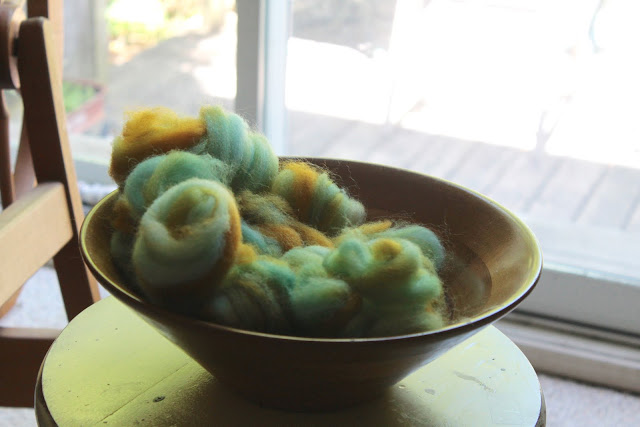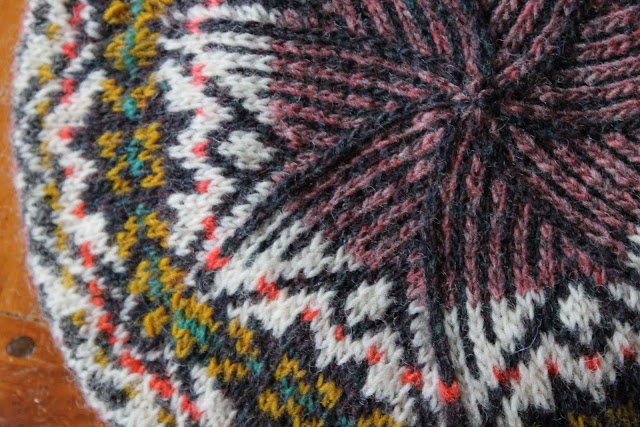The (In)definite answer on Falkland Wool
Earlier this month I stopped in at the Vendor's sale of the Ontario Handspinning Seminar, held in Kingston. I was drawn to this odd colour combination:
It kind of reminds me of goldfish swimming in a pond. Mostly orange and aqua, with little bits of green.
The base is "Falkland Wool" which was a new spin for me, an added bonus. I got this one because of the colours, but I'm also learning that I like starting from a washed or raw fleece, still in locks, because I get a real sense for the fibre, even before carding it. I guess that's where breed books like the Fleece and Fiber Sourcebook step in, though.
When I mentioned on insta that I was trying Falkland for the first time, people seemed excited. "It's kinda like merino." "It's bouncy; fun to spin." That's the general concensus, if you poll the internet at large.
But, Falkland isn't a single, specific breed. There is no sheep named the Falkland. But you could adjectively describe a sheep as Falkland. So what does it mean that I have Falkland wool on my wheel?
Mostly generally, it means it was raised on the Falkland Islands. More specifically, Falkland wool, by heritage, is largely a mix of Merinos and Polworths, with some Corriedale and Romney tossed in. Rather that breeding a single sheep, new breeds were added as needed, to keep the sheep healthy. So your batt will most likely be partly Merino or Polwarth or Corriedale (a breed from Lincoln-Merino), and be bouncy and soft, as you would expect looking at the characteristics of those two breeds (See a picture of Polwarth Locks here, showing both their length, and tighter crimp.) Blacker Yarns, purveyor of lovely breed specific wools, works with a specific farm for their Falkland Merino Yarn. It seems, from what I've read, that each farm makes decisions about when to add "new blood" to their Falkland flock, and so the precise bloodline will differ from farm to farm (i.e. Blacker's contact Falkland farm is mostly Merino with Corriedale). Sure, several new breeds are younger than than the continuous sheep history of the Falkland Islands, but my understanding is that intentionality is what separates them: new genes were only added every now and then to keep the flocks healthy, rather than controlled genetics with the intention of creating a new breed. As mentioned, this intentionality occurs at the farm level.
This doesn't mean that there isn't something unifying about "Falkland fleece," or that you can't anticipate what you are buying because it is not breed specific. You can! For example, Falkland is a fairly tiny region, geographically, so all sheep raised there have access to the same food sources and are raised in the same climate. Almost all land is used for sheep. Also, because of the climate and the bug life, Falkland fleeces aren't dipped in pesticides and there is no mulesing. It's also well regulated, for quality control by the QFW board (Quality Falkland Wool). It's the small, more isolated nature of the Falkland Wool industry that ensures consistency. So expect bounce, and soft but not halo-like softness.
73% of economic revenue in Falkland comes from sheep; it's difficult but lovely for me to imagine a culture which revolves entirely around the year of sheep farming. The Falkland coat of arms even has a sheep on it.
Falkland is also one of the only places I know of where you can find penguins and sheep in the same region, so it's got that going for it. Now I want to visit. Shetland Isles first, but maybe the Falklands eventually.
It kind of reminds me of goldfish swimming in a pond. Mostly orange and aqua, with little bits of green.
When I mentioned on insta that I was trying Falkland for the first time, people seemed excited. "It's kinda like merino." "It's bouncy; fun to spin." That's the general concensus, if you poll the internet at large.
But, Falkland isn't a single, specific breed. There is no sheep named the Falkland. But you could adjectively describe a sheep as Falkland. So what does it mean that I have Falkland wool on my wheel?
Mostly generally, it means it was raised on the Falkland Islands. More specifically, Falkland wool, by heritage, is largely a mix of Merinos and Polworths, with some Corriedale and Romney tossed in. Rather that breeding a single sheep, new breeds were added as needed, to keep the sheep healthy. So your batt will most likely be partly Merino or Polwarth or Corriedale (a breed from Lincoln-Merino), and be bouncy and soft, as you would expect looking at the characteristics of those two breeds (See a picture of Polwarth Locks here, showing both their length, and tighter crimp.) Blacker Yarns, purveyor of lovely breed specific wools, works with a specific farm for their Falkland Merino Yarn. It seems, from what I've read, that each farm makes decisions about when to add "new blood" to their Falkland flock, and so the precise bloodline will differ from farm to farm (i.e. Blacker's contact Falkland farm is mostly Merino with Corriedale). Sure, several new breeds are younger than than the continuous sheep history of the Falkland Islands, but my understanding is that intentionality is what separates them: new genes were only added every now and then to keep the flocks healthy, rather than controlled genetics with the intention of creating a new breed. As mentioned, this intentionality occurs at the farm level.
This doesn't mean that there isn't something unifying about "Falkland fleece," or that you can't anticipate what you are buying because it is not breed specific. You can! For example, Falkland is a fairly tiny region, geographically, so all sheep raised there have access to the same food sources and are raised in the same climate. Almost all land is used for sheep. Also, because of the climate and the bug life, Falkland fleeces aren't dipped in pesticides and there is no mulesing. It's also well regulated, for quality control by the QFW board (Quality Falkland Wool). It's the small, more isolated nature of the Falkland Wool industry that ensures consistency. So expect bounce, and soft but not halo-like softness.
73% of economic revenue in Falkland comes from sheep; it's difficult but lovely for me to imagine a culture which revolves entirely around the year of sheep farming. The Falkland coat of arms even has a sheep on it.
 |
| Falkland Coat of Arms |
Falkland is also one of the only places I know of where you can find penguins and sheep in the same region, so it's got that going for it. Now I want to visit. Shetland Isles first, but maybe the Falklands eventually.
 |
| This fence was put up to protect the sheep, but it's well attended by the penguins. Wikipedia commons |
Check out this cool picture at Modern Farmer. I want to share it, but I'm unsure about using someone else's photo without explicit permission. The above photo is from Wikipedia commons, and has no licensing.




I just stumbled upon your blog and this was so interesting! I am a fairly new spinner and I am very interested in all the different kinds of wool and preperation and spinning of it! This was a delightful read and great pictures!
ReplyDeleteAwww, thank you very much Sarah. Glad to hear that it has been interesting to you as a beginning spinner. I hope to include helpful ideas and content, not just a rolling roster of my works in progress. Thank you for your comment.
Delete